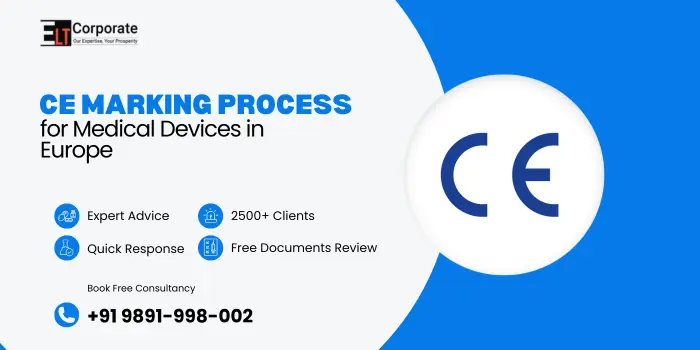If you want to sell medical devices in Europe, you must get the CE marking under the EU Medical Device Regulation (MDR, Regulation EU 2017/745). The CE mark shows that your device meets strict safety, performance, and regulatory requirements, and you can legally place it in the EU and EEA markets.
With recent regulatory changes, tight enforcement, and updated guidance, medical device manufacturers must clearly understand the CE marking process in 2025. This guide walks you through each step-preparation, documentation, conformity assessment, and post-market obligations.
What is CE Marking for Medical Devices?
The CE Mark is a quality and safety symbol that stands for “Conformité Européenne,” meaning “European Conformity.”
It confirms that your medical device complies with EU MDR (2017/745) and meets all requirements for safety, performance, and labelling.
Devices without a CE mark cannot be sold in the European market.
Why is CE Marking Important for Medical Device Companies?
CE marking is crucial because it:
- Allows market access in EU and EEA countries.
- Builds trust among patients and healthcare professionals.
- Ensures product safety and reliability.
- Helps in global recognition of your medical device.
- Reduces legal risks and regulatory penalties.
Without it, your product can be rejected or banned from the market.
What Are the Updated CE Marking Regulations in 2025?
In 2025, CE marking is regulated by:
1. EU MDR 2017/745 (for medical devices).
2. EU IVDR 2017/746 (for in-vitro diagnostics).
Key updates include:
- Stricter rules on clinical data and post-market surveillance.
- Extended transitional timelines (under Regulation 2024/1860).
- Digital registration of devices under EUDAMED.
- Mandatory Unique Device Identification (UDI).
These updates make compliance more transparent and traceable.
What Are the Steps in the CE Marking Process for Medical Devices?
Here is the step-by-step process to obtain CE marking in 2025:
Step 1: Identify Whether Your Product Is a Medical Device
Check if your product fits the MDR definition of a medical device (based on intended purpose and risk).
Step 2: Classify Your Device
Determine its class under Annex VIII of MDR:
- Class I – Low risk (e.g., stethoscopes).
- Class IIa – Medium risk (e.g., infusion pumps).
- Class IIb – Higher risk (e.g., ventilators).
- Class III – High risk (e.g., pacemakers).
The higher the class, the stricter the requirements.
Step 3: Choose the Conformity Assessment Procedure
Depending on the device class:
- Class I (non-sterile, non-measuring): Self-declaration is allowed.
- Class IIa, IIb, III: You must involve a Notified Body (NB) for review and certification.
Step 4: Appoint a European Authorized Representative (If Outside EU)
If your company is not based in Europe, you must appoint an Authorized Representative within the EU who will act as your legal contact for regulators.
Step 5: Implement a Quality Management System (QMS)
A QMS ensures quality in manufacturing and post-market activities. Most companies follow ISO 13485:2016, which aligns with MDR requirements.
Step 6: Prepare Technical Documentation
Your Technical File (or Design Dossier for higher classes) must include:
- Device description and intended use.
- Risk management report.
- Design and manufacturing information.
- Clinical evaluation and performance data.
- Labeling, Instructions for Use (IFU), and packaging.
- Post-market surveillance plan.
This must follow Annex II & III of MDR.
Step 7: Conduct Clinical Evaluation
Collect and analyze clinical data proving your device’s safety and performance.
For high-risk devices, you may need clinical trials or literature-based evidence.
Step 8: Undergo Notified Body Review (If Required)
For medium- and high-risk devices, the Notified Body will:
- Audit your manufacturing site.
- Review your technical documentation.
- Verify compliance with MDR.
If approved, they issue a CE Certificate of Conformity.
Step 9: Prepare Declaration of Conformity (DoC)
After successful review, you must sign a Declaration of Conformity, stating that your device meets all relevant MDR requirements and harmonized standards.
Step 10: Affix the CE Mark
Now, affix the CE Mark visibly on:
- The product
- Packaging
- Instructions for Use
If a Notified Body is involved, include their four-digit identification number next to the CE mark.
Step 11: Register the Device in EUDAMED
Upload your device details in EUDAMED, the European medical device database, along with your Unique Device Identifier (UDI).
Step 12: Post-Market Surveillance (PMS)
After your device enters the market, you must:
- Collect user feedback.
- Report incidents or complaints.
- Submit periodic safety update reports (PSUR).
- Conduct vigilance activities to monitor safety.
How Long Does the CE Marking Process Take?
On average:
- Low-risk devices (Class I): 3–6 months.
- Medium to high-risk devices: 8–18 months (depending on documentation and Notified Body availability).
Delays can occur if documents are incomplete or testing is required.
What Are the Common Challenges in 2025?
- Shortage of Notified Bodies causes long review timelines.
Complex clinical data requirements. - EUDAMED registration delays.
- Frequent regulatory updates and stricter labeling rules.
- Integration with AI/Software device guidance under MDR and EU AI Act.
What Are the Benefits of CE Marking?
- Legal access to the EU market.
- Global recognition of compliance.
- Strengthened brand credibility.
- Safer and more reliable devices.
- Long-term business sustainability.
What Happens After Getting the CE Mark?
After certification, manufacturers must:
- Maintain QMS and surveillance systems.
- Keep technical documentation updated.
- Conduct post-market follow-up and audits.
- Renew certifications before expiry (typically every 3–5 years).
Can I Sell My Device in the UK With a CE Mark?
No. Since Brexit, the UK requires UKCA marking, though CE marking is accepted temporarily until 2028.
Who Regulates CE Marking for Medical Devices in Europe?
CE marking is regulated under the EU MDR 2017/745 and monitored by EU Notified Bodies and national competent authorities.


Comments are closed